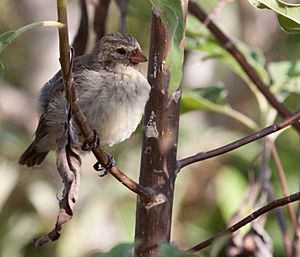Small tree finch facts for kids
Quick facts for kids Small tree finch |
|
|---|---|
 |
|
| Conservation status | |
| Scientific classification | |
| Genus: |
Camarhynchus
|
| Species: |
parvulus
|
 |
|
| Synonyms | |
|
Geospiza parvula |
|
The small tree finch (Camarhynchus parvulus) is a type of bird that lives in the Galapagos Islands. It belongs to a special group called Darwin's finches, which are part of the tanager family.
This finch has a strong beak that helps it grab things. Its beak is curved, which is perfect for its diet. Small tree finches live in warm, dry places like subtropical forests and areas with lots of shrubland. When they are not breeding, these birds sometimes gather in big groups with other small finches.
The small tree finch is found only on the Galapagos Islands. Experts say it is a species of "Least Concern," meaning it is not in immediate danger. However, studies since 1997 show that their numbers are slowly going down in some areas. This is especially true in places where they are most common. A tiny, harmful insect called the avian vampire fly is a big problem for these birds. Its larvae can hurt the finch chicks.
Contents
Where Small Tree Finches Live
The small tree finch can be found on most of the main Galapagos Islands. However, you won't see them on Española, Genovesa, Marchena, Darwin, or Wolf islands. In recent years, they have also not been seen on Rábida, Pinta, and Santa Fé islands.
How Small Tree Finches Reproduce
Small tree finches build special dome-shaped nests. They use these nests to attract a partner and to lay their eggs.
Male Finches Attract Mates
When a male small tree finch finishes building his nest, he sings nearby. This song is meant to attract female finches. When a female arrives, she will check out the nest. She might even go inside to inspect it.
After checking the nest, the female has a few choices:
- She might like both the male and his nest, and they will become a pair.
- She might like the male but not his nest. In this case, they will build a new nest together.
- She might not like either the male or his nest, and she will fly away.
Older Males Build Better Nests
Older male finches are very good at building hidden nests. These nests are usually higher up in the trees. This helps protect the eggs and chicks from animals that might try to eat them. Younger males are not as good at hiding their nests.
Female finches prefer to mate with older males. This is because pairs with older males have more chicks that survive and fly away from the nest. Many nests are lost because other animals eat the eggs or chicks. So, building a well-hidden nest is very important for survival.
What Makes a Male Attractive
Males who sing well are more likely to find a mate. Their singing ability is linked to the shape of their beak. Also, finches often choose partners that are similar in size to themselves. So, many things help a male small tree finch find a partner: his age, how well he sings, how well he hides his nest, and the size of his body and beak.
What Small Tree Finches Look Like
Small tree finches change their feathers every year. Female finches stay grey-brown their whole lives. Male finches are born grey-brown, just like females. But as they get older and change their feathers each year, the top of their head and their chin become black. You can often tell how old a male finch is by how dark his head and chin are. The darker they are, the older the male usually is.
What Small Tree Finches Eat
The small tree finch mostly eats insects. However, they also have a varied diet. They often look for insects and small creatures on tree bark and leaves. About 42% of what they eat comes from plants. This includes things like nectar, fruits, and seeds.
See also
 In Spanish: Pinzón de Darwin chico para niños
In Spanish: Pinzón de Darwin chico para niños


